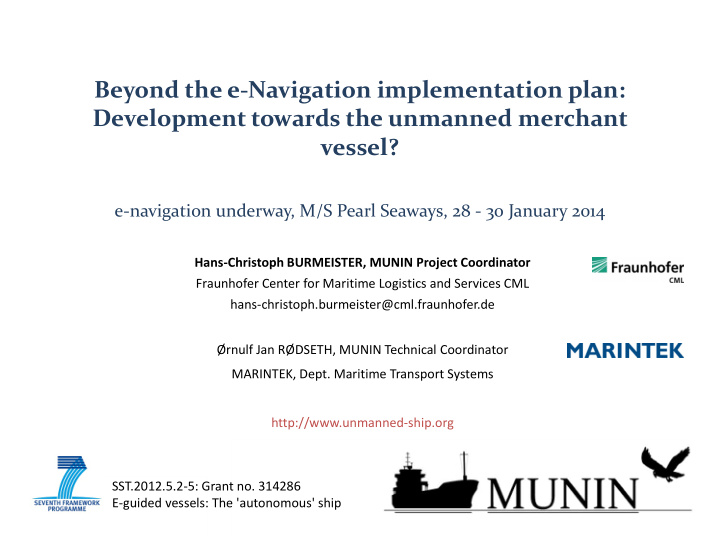



Beyond the e-Navigation implementation plan: Development towards the unmanned merchant vessel? e-navigation underway, M/S Pearl Seaways, 28 - 30 January 2014 Hans-Christoph BURMEISTER, MUNIN Project Coordinator Fraunhofer Center for Maritime Logistics and Services CML hans-christoph.burmeister@cml.fraunhofer.de Ørnulf Jan RØDSETH, MUNIN Technical Coordinator MARINTEK, Dept. Maritime Transport Systems http://www.unmanned-ship.org SST.2012.5.2-5: Grant no. 314286 E-guided vessels: The 'autonomous' ship
Content MUNIN’s Vision and Rationale MUNIN’s concept MUNIN and e-Navigation Outlook 2
MUNIN Key facts Maritime Unmanned Navigation through Intelligence in Networks European FP7 project from Sep 2012 to Aug 2015 8 partners with 2.9 million € funding Focus: Develop a concept for an unmanned merchant vessel Validate concept in a simulator set-up 3
Rationale for unmanned vessels Sustainability and short term use Current challenges of maritime Autonomous ship as a long-term shipping: solution to: Highly competetive industry Reduce operational expenses Lack of young professionals Attract professionals Rising ecological awareness Reduce environmental impact 4
Feasibility restriction Remote control not sufficient €€€ > 150.000 USD/Month 5
Definition MUNIN‘s autonomous ship Autonomous ship Autonomous ship Next generation modular control systems No persons on board for whole or part of and communications technology [that] the voyage. The ship, with partial help will enable wireless monitoring and from remote control, must be able to control functions both on and off board. manage the voyage on its own. These will include advanced decision support systems to provide a capability to operate ships remotely under semi or fully autonomous control. 6
Use Case Dry bulk carrier on deep-sea-voyage Berth Approach Transit Approach Berth Reasons: Long deep-sea-voyage Low risk cargo Slow steaming attractivness 7
State-of-the-project Prototype implementation begins WP 1 Administrative coordination WP 2 Technical coordination WP 8 Proof of concept WP 10 Future concepts WP 3 Dissemination WP 4 Architecture WP 5 Autonomous bridge WP 7 Shore side operation centre WP 6 Autonomous engine room WP 9 Assessment 1. Scenario definition 4. Proof-of-concept 2. Technical specification 5. Assessment 3. Prototype implementation 6. Future concepts 8
Content MUNIN’s Vision and Rationale MUNIN’s concept MUNIN and e-Navigation Outlook 9
MUNIN Vision Still manned operation in coastal waters 10
Main Challenge Unmanned, but not out-of-the-loop § € If x else a --> 2.5 b =! 3.04 … {notify} $ship_env waiting… 11
New systems enabling autonomous navigation during deep-sea voyage Advanced Autonomous Shore Sensors System Navigation System Control Centre Electronic lookout Op. decision-making Human element Detect small objects Avoid collisions Monitor voyage and vessel Detect weather Ensure stability in phenomena harsh weather Problem-solving 12
Operational modes on-board Restricted interaction must be respected 13
Autonomous execution The main operational mode Ship system activities UAV: Autonomous execution Follow predefined voyage plan Observe environment Measure ship conditions Shore Control Centre Monitor ship status Communication SCC: Remote monitoring Periodic updates ship-to-shore 14
Autonomous control Handling of known events Ship system activities UAV: Autonomous control Autonomously adapt voyage plan If required: Involve Shore Control Shore Control Centre Ensure safe operation If required: Acknowledge decision Communication SCC: Monitoring/Investigation Event-based data exchange 15
Remote control Intervention in a special situation Ship system activities UAV: Remote control Provide navigational data Control is overrided by Shore Control Shore Control Centre Directly operates ship (remote bridge) If required: Acknowledge decision Communication SCC: Remote Operation Direct link (communication tunnel) 16
Content MUNIN’s Vision and Rationale MUNIN’s concept MUNIN and e-Navigation Outlook 17
Prioritized e-Navigation solution S1: improved, harmonized and user-friendly bridge design; S2: means for standardized and automated reporting; S3: improved reliability, resilience and integrity of bridge equipment and navigation information; S4: integration and presentation of available information in graphical displays received via communication equipment; and S9: improved Communication of VTS Service Portfolio (not restricted to VTS stations). 18
S1 Bridge design New sensor/detection systems MUNIN needs improved sensor systems and automatic small and large target detection. This could also assist OOW and outlook of conventional ships. 19
S2 Reporting Reporting from shore control centre Single point Of reporting All mandatory ship reporting must be handled by shore control center in MUNIN. This can also be pattern to relieve officers of administrative burdens. 20
S3 Navigational data reliability Improved navigational data fusion As no crew is available to correct errors, improved and higher quality sensor and data fusion becomes necessary, including advanced object detection, AIS, GPS, other ship sensors as well as any other source that is available. 21
S4 Graphical displays (1/2) SCC displays for situation assessment Shore control centre will normally be in charge of several ships. When something unexpected happen, they will need to be able to rapidly assess the sitaution as well as status of other ships. This can also be very useful onboard! 22
S4 Graphical displays (2/2) Technical condition monitoring TCI Visualization Aggregation functions TCI Aggregation functions … TCI Configuration Status Input functions functions Measurements Data acquisition modules Deviation Adm. Automation reports system Keeping track of technical condition of equipment, operational consequences in case of failures and planning of maintenance is critical for MUNIN. This is functionality that can also be used in conventional shipping operations. 23
S9 VTS Service portfolio Concept of SCC to assist OOW Status intervention Remote control Remote monitoring MUNIN will rely on a shore control center to supervise and control unmanned ships. Functionality here can also be used to assist OOW of conventional ships, e.g., during nighttime or when little is expected to happen onboard. 24
Content MUNIN’s Vision and Rationale MUNIN’s concept MUNIN and e-Navigation Outlook 25
Outlook MUNIN on tour Date Event Location 28.-30.01.2014 MUNIN @ e-navigation underway 2014 Pearl Seaways, DK/NO 14.-17.04.2014 Presentation: MUNIN safety impacts at Paris, FR TRA 2014 12.-14.05.2014 Scientific session on MUNIN during Redworth, UK COMPIT 2014 10.09.2014 MUNIN workshop „Short-term Hamburg, DE application“ during SMM 10.-11.06.2015 MUNIN final promotion event Hamburg/Rostock, DE Jun 2014 In-situ test of Advanced Sensor System MUNIN internal Sep 2014 1st Full-scale simulation test MUNIN internal Feb 2014 2nd Full-scale simulation test MUNIN internal 26
Conclusion Maritime Unmanned Navigation through Intelligence in Networks Is MUNIN an e-Navigation test-bed? 27
Thank you for your attention 28
Recommend
More recommend